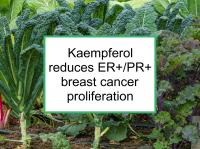Kaempferol is a flavonol found primarily in plants such as kale, broccoli, chives, dill, saffron, and certain greens such as arugula. Flavonols (also including quercetin and fisetin) are a class of flavonoid. A 2013 meta-analysis of previous studies reported that women with high flavonol intake had a 12% lower risk of breast cancer than those with low intake.
Now a new study has reported that kaempferol's chemopreventive effects in hormone receptor positive (ER+/PR+) breast cancer cells are due in part to inhibition of glucose uptake.
Flavonoid types
Flavonoids can subdivided into six major groups: flavones, flavonols, anthocyanins, isoflavones, flavan-3-ols, and flavanones. There are thousands of flavonoids in total. Below are the most abundant and well studied flavonoids with respect to breast cancer risk:
- Flavones: apigenin, luteolin, tangeretin, tricin
- Flavonols: fisetin, kaempferol, quercetin
- Anthocyanins: delphinidin, cyanidin, malvidin, pelargonidin
- Isoflavones: daidzein, genistein
- Flavan-3-ols: catechin, epigallocatechin, epicatechin
- Flavanones: hesperetin, naringenin.
Kaempferol helps protect heart from doxorubicin chemotherapy
Kaempferol has been shown to reduce the cardiomyopathy caused by doxorubicin chemotherapy in rats. The usefulness of doxorubicin is limited by its cardiotoxicity, which can lead to heart failure in susceptible breast cancer patients. Some compounds that decrease side effects do so at the cost of potentially reducing the effectiveness of treatment.
Not so for kaempferol, which appears to use a mitochondrion-dependent pathway to inhibit the doxorubicin-induced cardiotoxicity. It has been demonstrated that the cytotoxicity of doxorubicin against cancer cells is not reduced by exposure of the cells to kaempferol.
Note that while black tea and green tea dietary sources of kaempferol, they might reduce the effectiveness of doxorubicin and other anthracycline chemotherapy through their caffeine content.
Latest research finds kaempferol reduces ER+/PR+ breast cancer glucose uptake
The study referenced at the beginning of this news story was designed to investigate the effects of five polyphenols (myricetin, chrysin, genistein, resveratrol, kaempferol, and xanthohumol) on the uptake of glucose by hormone receptor positive breast cancer cells. In the absence of any of the polyphenols, uptake of 3H-deoxy-D-glucose ("glucose") by ER+/PR+ MCF-7 breast cancer cells was time-dependent, capable of being saturated so that no more could be absorbed (saturable), and inhibited by cytochalasin B plus phloridzin.
Myricetin, chrysin, genistein, resveratrol, kaempferol, and xanthohumol (at concentrations of 10-100 µM) all were found to inhibit glucose uptake in the short-term (26 minutes). Kaempferol was the most potent short-term glucose uptake inhibitor. Kaempferol (30 µM) was also able to inhibit glucose uptake (associated with a 40% decrease in GLUT1 mRNA levels) in the long-term (defined as 24 hours). At 100 µM, kaempferol demonstrated antiproliferative and cytotoxic properties similar to those caused by low extracellular glucose conditions and reversible by high extracellular glucose conditions. In addition, exposure of MCF-7 cells to kaempferol (30 µM) caused higher extracellular lactate levels over time as a result of inhibition of cellular lactate uptake.
The authors conclude that kaempferol potently inhibits glucose uptake by ER+/PR+ breast cancer cells, apparently by decreasing GLUT1-mediated glucose uptake. The authors further comment that the antiproliferative and cytotoxic effect of kaempferol in these cells appears to be dependent on this effect.
